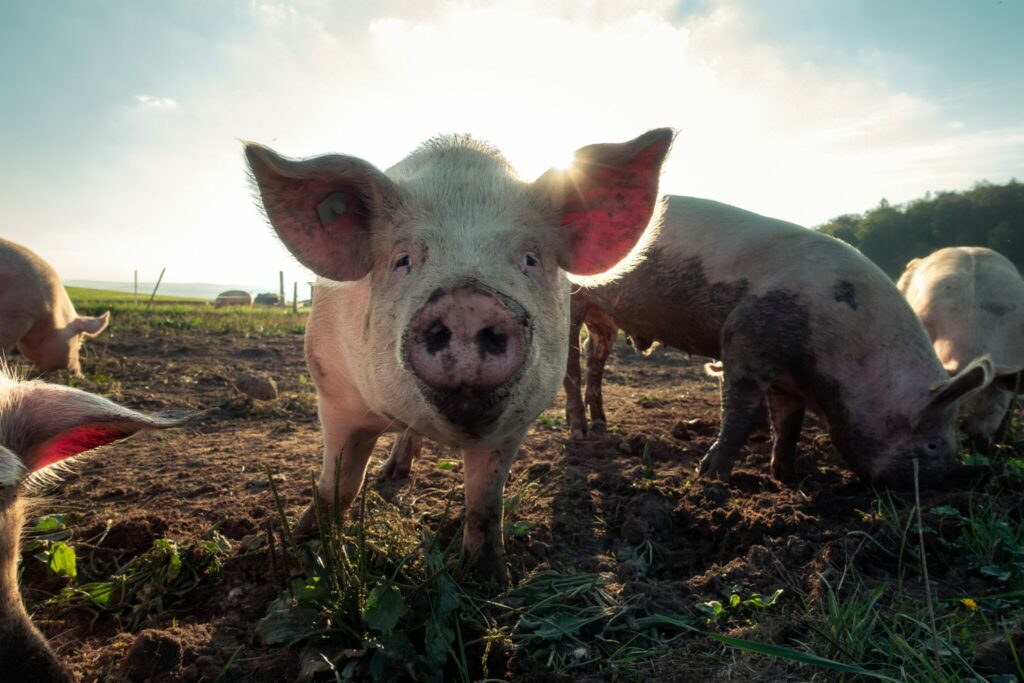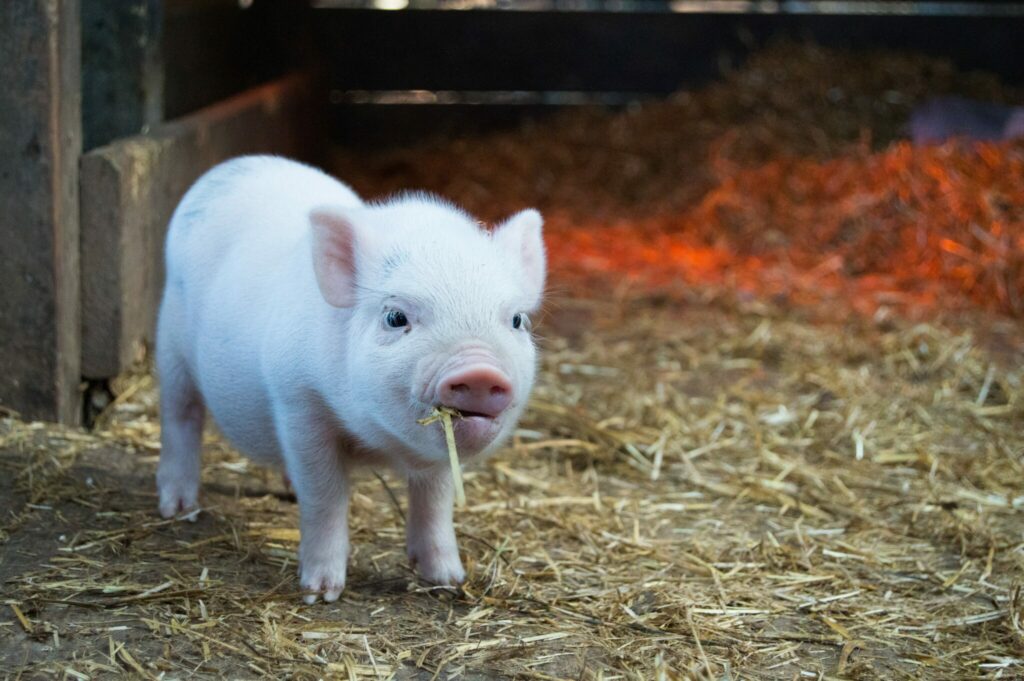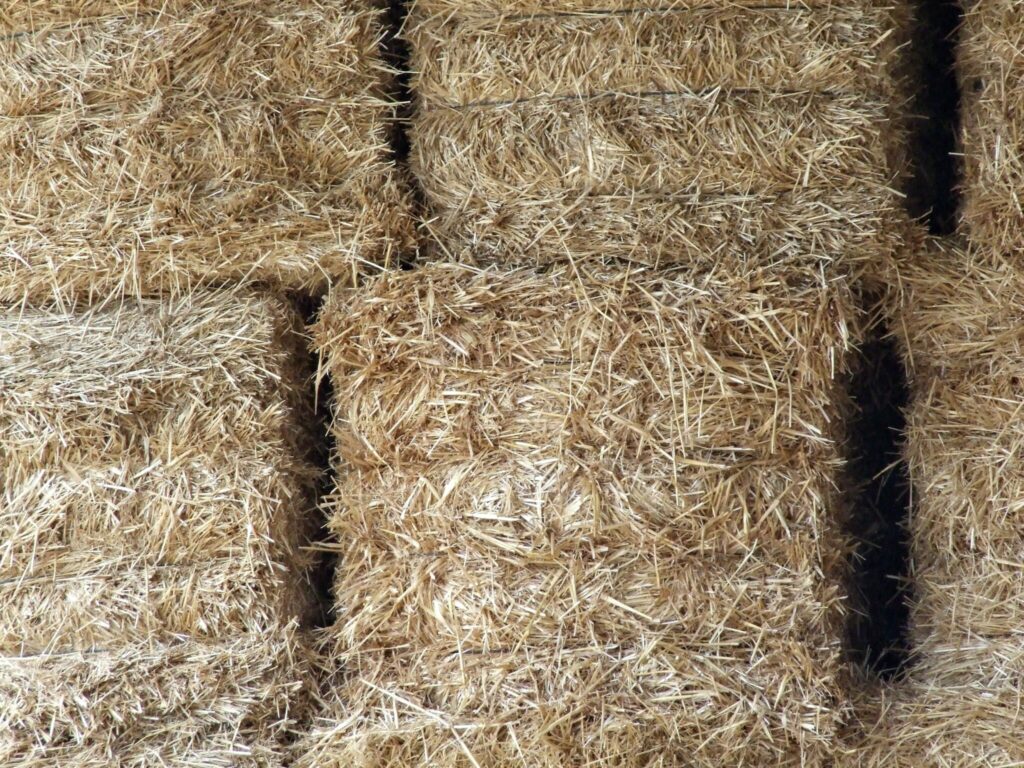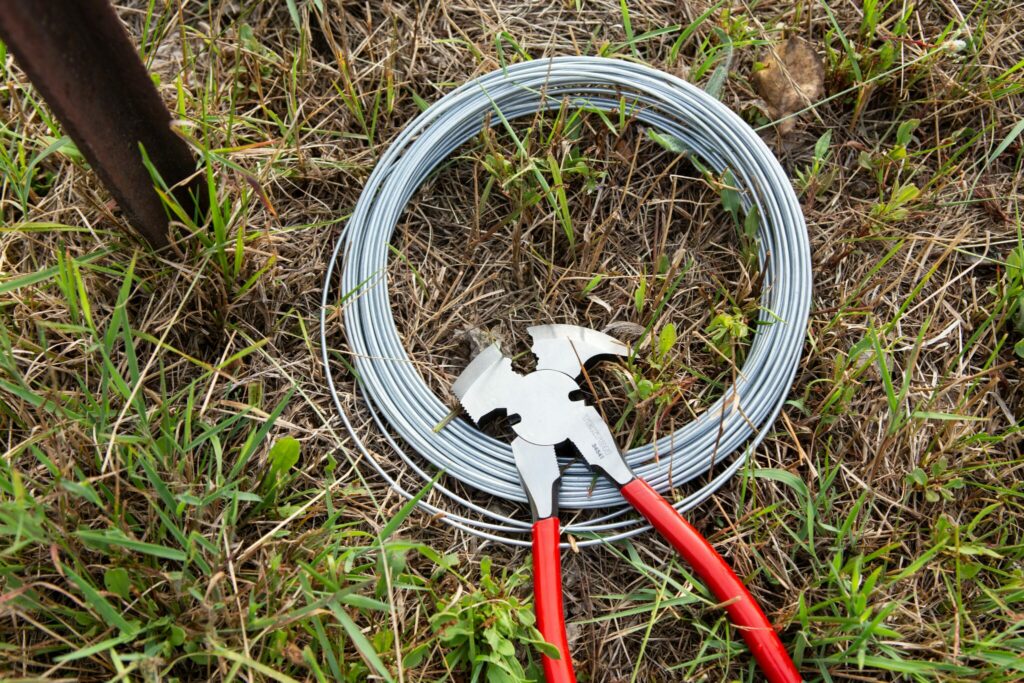Minimizing Waste with Pastured Pigs

Have you ever thought about the waste generated by having livestock? In a traditional setup, you oftentimes find plastic buckets, plastic bagged feed, plastic ropes and ties, and so on. Plastic, although commonly referred to as “recyclable,” is actually not recyclable.
A recyclable material can be cycled though over and over without losing its original characteristics or integrity. Examples of this would be most metals and glass. Plastic, on the other hand, loses its integrity after re-processing. Generally speaking, a plastic water bottle that is placed in recycling will not be used again as a plastic water bottle. It will not be recycled, but instead, will be downcycled into park benches or carpet.
Downcycling recycles the material into a lower quality substance, which is then used to create a lower-grade product. This is often because the nature of the material prevents it from retaining its former durability once re-processed. Thus, downcycling does not reinsert the material back into its original cycle. The result of downcycling is, for example, the creation of cleaning rags out of clothing, or newspaper out of writing paper. Paper and plastic are two materials that do not recycle well, and as a result are often downcycled instead.
From MaterialTrader
When it comes to caring for livestock, what are our alternatives? This post is to share a few of the products and ways we endeavor to minimize waste on our homestead, specifically with our pastured pigs.

Feed
While pigs raised on pasture do enjoy lots of goodies found in the grass and soil, the majority of their calories and nutrients come from their feed. For containers, instead of opting for plastic or synthetic rubber buckets/pans, we purchased these 3-gallon metal utility pans. Our three pigs share two pans currently. This 4-quart metal scoop has come in handy for scooping now that we are feeding our pigs larger quantities of feed. We found old plastic trash bins in our barn that are working well for storing a few bags of feed at a time, but should we find the need to purchase something new, this 20-gallon metal bin with lid is probably what we would choose.
A note on feed bags – Our current feed unfortunately comes bagged in plastic. If we had a larger number of pigs, we would be able to justify ordering feed by the pallet to minimize waste. With only three pigs, purchasing feed in 50 pound quantities is most cost effective and smart for our storage setup. For the most part, we try to hold onto the empty bags in case we have a future use for them, such as to collect trash. We are not aware of a source of 100% organic pig feed bagged in paper, but we would definitely consider switching to that if we found one and the cost per pound was similar to what we pay now for our locally-milled, 100% organic feed.
Water
Our pigs are in an area of pasture where we do not have a water source. Instead, we can choose to carry down water a few times a day using 5-gallon buckets, or we can string together hoses to reach from the back of our house to the pasture. We did the 5-gallon bucket solution for a few weeks, but we are thankful to report that we have found a different solution!
After watching many tutorials on Youtube, we decided to make our own pig barrel waterer. We purchased a food-grade, metal 55-gallon barrel from someone in a neighboring city, this 1/2 inch hole saw for drilling into the metal barrel, this 1/2 inch plastic threaded female adapter union fitting for the pig nipple (there was not a plastic-free alternative for this!), this 1/2 inch stainless steel nipple drinker, and this silicone aquarium sealant. It took a little trial and error, but we finally got the barrel waterer to work. Now, we just need to fill up the barrel once every few days, using the hoses mentioned earlier! It was a bit of a toss up to use a metal barrel instead of a plastic one (we could not find a single tutorial using a metal one), but we are really pleased with how it turned out!

Bedding and Shelter
Our pigs’ bedding is locally cut and baled straw. We have not found a truly organic source, so the best we can do right now is buy from a nearby farm that collects the straw following hay mowings for horses. This baled straw does come tied with plastic string, but we have been able to find a few different uses around the homestead for the string. In our situation, this local option is still preferred over straw bagged in plastic. We have opted to leave the soiled straw to decompose in the immediate area of wherever our pigs are, but in theory, we could scoop up the soiled straw and add it to a compost pile. The pigs use the bathroom in their pasture, and because we rotate the pigs, we do not have any animal waste to collect. It goes right back into the earth to decompose!
For their shelter, we used wooden pallets and scrap wood and configured them into a three-sided and lightly roofed structure. We did not even have to buy screws for it, as we had plenty to choose from in our assorted leftover screws and nails box. If and when we decided to take down the structure, everything can either be composted or recycled!

Fencing
In an ideal situation, perhaps we would be able to use wooden fence posts made from our felled trees and then string uncoated, metal wire to fence in our pasture area(s). Our current practical and more affordable solution, however, is to use a combination of metal T-posts found in our barn, fiberglass step-in posts, and electric wire fencing (see below for more details).
We went back and forth a bit on figuring out the fencing side of things because we wanted to choose something that was moveable and also adaptable, should we add other livestock to our homestead. Below, we have listed each of the fencing materials we have and how we are using them for our pastured pigs:
- metal T-posts for the corners of the fencing (provide more stability, hold corners tight; we got ours from our barn)
- plastic T-post insulators (to hold the wire at the corners; we could only find plastic ones for Tposts, but there are ceramic options for wooden posts–keep in mind that ceramic cannot be recycled)
- metal T-post gate anchors (so we can clip and unclip the gate handles from the Tposts)
- metal T-post pounder (for installing t-posts)
- fiberglass step-in posts for the remaining perimeter (these have built-in insulators, so we did not have to buy additional ones for the remaining perimeter, which we would have done if we went with simple metal rebar posts)
- rubber gate handles (not technically necessary, but will come in hand for when we need to move the pigs to new pasture and for when we need to back up a trailer into the pasture or haul a cart of something to the pigs)
- copper grounding rod (to complete the electrical circuit)
- aluminum ground rod clamp (to connect insulated wire from grounding rod to solar energizer)
- galvanized electric fence wire (the actual fence!)
- 10 mile solar-powered electric fence energizer (what provides the electric charge to the wire fence)
- insulated wire (to connect the fence wire to the solar charger + the grounding rod to the solar charger; we found some in our garage leftover from house projects)
Some of the reasons we chose this type of electric fencing include: we can adjust the number and height of the strands of fence wire to accommodate different livestock (ex: move wire higher for cows or horses, lower for piglets); it is portable and allows for rotational grazing; and it is a more affordable way to fence in larger areas of pasture compared to woven wire fencing or wood panel fencing.
As we learned more about the benefits of raising pigs on pasture (ex: they are able to exhibit their God-given, natural behaviors like rooting, chasing each other around, and foraging), we knew it was the way to go for our own pigs. And, although it took a bit more effort to find our way in raising them with minimal waste generated, we are really pleased with our current setup.
Do you have any experience minimizing waste with livestock, or perhaps even with your pets? Comment below to share with our community! If you have any questions regarding our pastured pigs, feel free to ask those in the comment section as well, or shoot us an email through our Contact Us page.
If you liked this post, you may also enjoy our post on 15 Ways to Reduce Waste with Your Pets.
We also have an entire page dedicated to blog posts on topic of Waste Reduction!
Yours truly,
Erica Barlow


 Fast Five – Edition No. 3
Fast Five – Edition No. 3